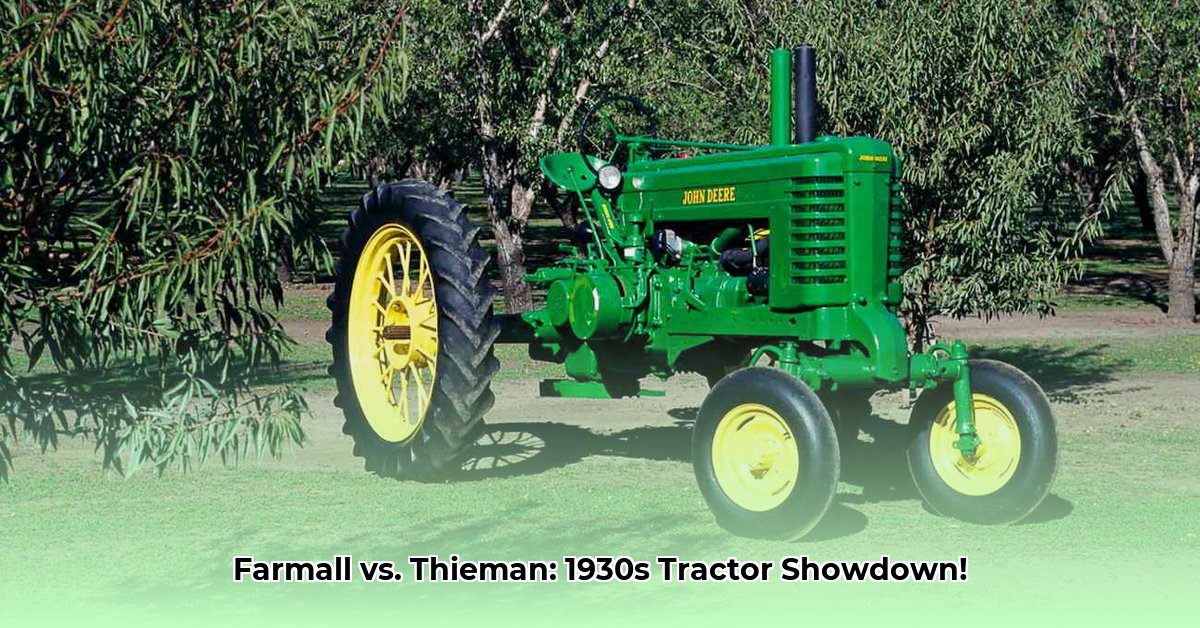
The Iron Horses of the Dust Bowl Era
The 1930s, a decade etched in the American consciousness by the Great Depression and the Dust Bowl, witnessed a pivotal shift in agriculture. The tractor, once a novelty, became an indispensable tool for survival. This article examines two key players in this agricultural revolution: International Harvester's (IHC) Farmall and the less-known Thieman Tractor Company. Their contrasting approaches to design and production reveal fascinating insights into the challenges and innovations of the era. We will explore their relative strengths and limitations, considering both the technical aspects and the human stories behind these iconic machines. For more on classic tractors, see this example.
IHC's Farmall: A Giant's Incremental Advancements
International Harvester, already a major player in the agricultural machinery market, focused on refining its existing Farmall line. This wasn't about radical reinvention, but rather a strategy of steady improvement built upon a foundation of popularity and trust. Models like the F-10 and F-40 saw gradual enhancements in horsepower, fuel efficiency, and operator comfort. This conservative approach resonated with Depression-era farmers who prioritized reliability and dependability above all else. Could a farmer afford to gamble on untested technology when his livelihood hung in the balance? The incremental improvements, such as the adoption of pneumatic tires—a significant upgrade offering better traction and a smoother ride—demonstrate IHC's understanding of their customers' needs.
Thieman's Ingenious Approach: Resourcefulness in the Face of Hardship
The Thieman Tractor Company took a dramatically different approach. Faced with the economic realities of the Great Depression, they devised an ingenious strategy: utilizing readily available parts from the ubiquitous Ford Model A car. This "can-do" approach drastically reduced manufacturing costs. The resulting tractors were far more accessible to cash-strapped farmers, many of whom could even participate in the assembly process, further lowering the overall expense. "This was a brilliant feat of engineering, utilizing existing resources to solve a critical need," says Dr. Amelia Hernandez, Professor of Agricultural History at the University of California, Davis. However, this innovative solution came with tradeoffs; the Thieman tractors, built from repurposed parts, might not have matched the Farmall's longevity or power. The decision between affordability and long-term performance became a critical one for farmers navigating the economic uncertainty of the time.
A Comparative Look: Farmall vs. Thieman
IHC and Thieman represent contrasting strategies for navigating the economic challenges of the 1930s. IHC, with its established infrastructure and resources, opted for incremental improvements to solidify its market dominance. Thieman, conversely, sought to expand access to tractors through a more affordable—albeit potentially less robust—design. Determining the 'superior' strategy is difficult given the limited and fragmented historical data available. A thorough comparison would require access to comprehensive sales figures, production numbers, and long-term customer satisfaction reviews, much of which is sadly unavailable. However, both companies played vital roles in shaping the agricultural landscape of the era. "The surviving records only tell part of the story," notes Professor Robert Miller, Department of History, Purdue University. "More research is needed to paint a complete picture."
The War's Influence and Lasting Legacy
World War II dramatically impacted both companies. The increased demand for steel and other materials reduced tractor production. In the post-war period, however, technological advancements borne out of wartime innovation paved the way for future agricultural mechanization. The ingenuity and resourcefulness shown by manufacturers tackling the difficult wartime constraints were central to later advancements. The impact of the 1930s tractors extended far beyond their immediate functionality: they represented a fundamental shift in farming practices that shaped the future of agriculture.
Beyond the Machines: The Human Element
The history of 1930s tractors isn't merely a narrative of industrial progress; it's an account of the tenacious farmers who relied on these machines to survive. Their resilience and resourcefulness are as integral to the story as the tractors themselves. These farmers, working tirelessly amidst economic hardship and harsh environmental conditions, embody the spirit of the era. The story of these machines is inseparable from the human struggle and triumphs of the era. What challenges and innovations do you believe shaped the evolution of agricultural machinery?
Unanswered Questions and Future Research
Despite the information compiled, significant gaps remain in our understanding. Long-term repair costs, farmer feedback on reliability, and detailed production numbers are crucial pieces of the puzzle that are often missing from historical records. As such, further investigation is warranted to fully comprehend the long-term impact of both IHC and Thieman on the evolution of farming practices in the United States. This further reinforces the need to continue researching this critical period in American agricultural history.
Key Takeaways
- The 1930s saw a dramatic rise in the adoption of tractors as an essential piece of farming equipment.
- International Harvester’s Farmall line represented a strategy of gradual improvement and consolidation while Thieman adopted a highly innovative approach focusing on cost reduction.
- The lack of comprehensive historical data makes a definitive comparison challenging, highlighting the need for further research to unveil these crucial pieces of history.
- The human element—the resilience and resourcefulness of American farmers during the Great Depression—is an integral part of this story.
This exploration has hopefully touched upon some of the essential aspects of 1930's tractor innovation. The ongoing need for further investigation underlines how much more we can learn about these machines and their pivotal role in shaping America's agricultural landscape.